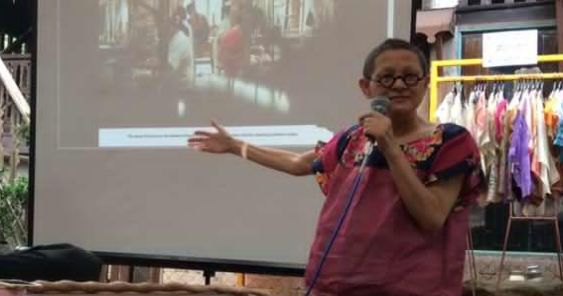Deciphering the language of threads at a mini cultural fair.
Bringing together seemingly disparate traditions in terms of needlework: the Tinggians of Abra and the lady seamstresses of Lumban, Patis Tesoro shows off a tapestry that integrates the weekend experience. A sturdy woven cotton blanket serves as the canvas on which Tesoro puts embellishing touches, directing her collaborators to add fine Lumban embroidery here, the addition of piña (processed pineapple fiber) there, the bold accents provided by Tinggian embroidery.
For visitors examining the various embroidered blankets, blouses, and scarves, the Tinggian craftswomen point out details like frogs (which symbolize fertility), the rivers/streams and rows of rice depicted on the cotton fabric, as well as the “kuko” or fingers/nails depicting the nimble handiwork of the women themselves. The textiles on display are embellished in various ways, including ingeniously hand-painted pina, producing a riot of color.
Staged last February 20-21 at the Patis Tito Garden Café in San Pablo, Laguna, the Embroidery Exchange featured stalls selling painted and embroidered textiles, beadwork, and farm produce or products sourced from Quezon and Laguna.

Why the exchange? It was meant to bring together the Tinggians and Lumban women to level up their skills and spark a discourse among the groups, as well as interest in the resulting works. And they can’t ask for a better ambassador than Patis Tesoro, who thoughtfully, tirelessly and passionately talks about the craft that goes into making pina, the labor-intensive process of harvesting, washing, sorting, weaving and sewing the fabric—resulting in a translucent and delicate fabric that commands premium prices, and is dwindling in demand/production by the very nature of its price and production.
Stitch work
Unfazed by competitors, or even the fiber blends that threaten to disrupt traditional production methods, Tesoro has in her own way documented and preserved these traditions but realized the only way to truly keep it alive was to make it practiced by the very people who relied on it for their livelihood—and make it lucrative for them. In fact, it isn’t unusual any longer to see heirloom pieces (traditionally handed from one generation to another) being put on sale just to put a family member through school.
After years of going back and forth like a shuttle on a loom, from San Juan to Laguna, from Manila to world capitals like Madrid, New York, Milan, and Washington, D.C. –Tesoro took the bold step of rooting herself in San Pablo, Laguna, and establishing a workshop/school there to encourage the preservation or continued practice of textile art. Located in the same compound as the café bearing her name, the creation of the Embroidery Exchange is but one of the many activities at the Patis Tito Garden Café, which champions sustainable lifestyles and cultural exchange.

Apart from the woven and embroidered work on display, the fair also showcased Tinggian dance, savory and sweet treats from Laguna/Quezon, as well as textiles and beads from Mindanao.
A journey worth braving traffic and the South Suffer-highway (and even the possibility of getting lost, but if you arm yourself with a map, you’ll have a very fair chance of making it to the café), it’s hoped that the Embroidery Exchange becomes an annual event, allowing for the cross-pollination of ideas and techniques. More importantly, with more awareness and appreciation for culture, people can encourage the survival of these living traditions.
For more information on future activities at the Patis Tito Garden Café, log on to: www.facebook.com/patistito










